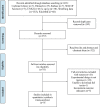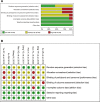Efficacy of acupotomy combined with sodium hyaluronate versus sodium hyaluronate alone in the treatment of knee osteoarthritis: A meta-analysis
- PMID: 37713816
- PMCID: PMC10508543
- DOI: 10.1097/MD.0000000000034930
Efficacy of acupotomy combined with sodium hyaluronate versus sodium hyaluronate alone in the treatment of knee osteoarthritis: A meta-analysis
Abstract
Background: The efficacy of acupotomy combined with hyaluronic sodium acid in the treatment of knee osteoarthritis (KOA) is unclear. Therefore, this meta-analysis aims to evaluate the efficacy of acupotomy combined with hyaluronic sodium acid compared with hyaluronic sodium acid alone in the treatment of KOA.
Methods: Studies from 8 Online databases were searched on KOA treatment using acupotomy combined with sodium hyaluronate until May 2022. The primary outcome indicator was clinical effectiveness, and the secondary outcome indicators included the visual analogue scale scores and Lysholm scores. We calculated the weighted mean difference (WMD) or relative risk for all relevant outcomes.
Results: Nine studies were identified, involving 644 cases. The results showed that acupotomy combined with intra-articular sodium hyaluronate injection for KOA was superior to sodium hyaluronate injection alone in terms of clinical effectiveness (relative risk = 1.17, 95% confidence interval [CI]: 1.09-1.25, P < .001) and visual analogue scale (WMD = -2.1, 95% CI: -2.25 to 1.95, P < .001), Lysholm score (WMD = 13.83, 95% CI: 3.47-24.19, P = .009).
Conclusion: Acupotomy combined with intra-articular sodium hyaluronate injection for KOA is superior to sodium hyaluronate injection alone. Limited by the number and quality of included studies, this conclusion still needs to be verified by more high-quality Research.
Inplasy registration number: INPLASY202350029.
Copyright © 2023 the Author(s). Published by Wolters Kluwer Health, Inc.
Conflict of interest statement
The authors have no funding and conflicts of interest to disclose.
Figures






Similar articles
-
A meta-analysis and systematic review of the therapeutic effects of arthroscopy combined with intra-articular injection of sodium hyaluronate in the treatment of knee osteoarthritis.Ann Palliat Med. 2021 Sep;10(9):9859-9869. doi: 10.21037/apm-21-2145. Ann Palliat Med. 2021. PMID: 34628912
-
Needle knife therapy plus sodium hyaluronate injection for knee osteoarthritis: A protocol for a systematic review and meta-analysis.Medicine (Baltimore). 2020 Nov 13;99(46):e23242. doi: 10.1097/MD.0000000000023242. Medicine (Baltimore). 2020. PMID: 33181712 Free PMC article.
-
Acupotomy combined with intra-articular injection of sodium hyaluronate in the treatment of knee osteoarthritis.Medicine (Baltimore). 2022 Sep 2;101(35):e30225. doi: 10.1097/MD.0000000000030225. Medicine (Baltimore). 2022. PMID: 36107551 Free PMC article.
-
Sodium hyaluronate and acupotomy bone decompression alleviates inflammatory responses in patients with knee osteoarthritis.Inflammopharmacology. 2025 Apr;33(4):1997-2005. doi: 10.1007/s10787-025-01667-4. Epub 2025 Feb 20. Inflammopharmacology. 2025. PMID: 39976668
-
Effect and safety of acupotomy in treatment of knee osteoarthritis: a systematic review and Meta-analysis.J Tradit Chin Med. 2020 Jun;40(3):355-364. doi: 10.19852/j.cnki.jtcm.2020.03.002. J Tradit Chin Med. 2020. PMID: 32506848
References
-
- Ringdahl E, Pandit S. Treatment of knee osteoarthritis. Am Fam Physician. 2011;83:1287–92. - PubMed
-
- Shimizu H, Shimoura K, Iijima H, et al. . Functional manifestations of early knee osteoarthritis: a systematic review and meta-analysis. Clin Rheumatol. 2022;41:2625–34. - PubMed
-
- Vas L, Khandagale N, Pai R. Successful management of chronic postsurgical pain following total knee replacement. Pain Med (Malden, Mass.). 2014;15:1781–5. - PubMed
-
- Lopez AD, Murray CC. The global burden of disease, 1990-2020. Nat Med. 1998;4:1241–3. - PubMed
Publication types
MeSH terms
Substances
LinkOut - more resources
Full Text Sources
Medical

